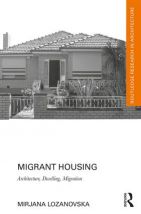Migrant Housing: Architecture, Dwelling, Migration

Author Mirjana Lozanovska sets out the premise of Migrant Housing early on (page 2): “In this book, empirical research on the migrant houses in two sites – the village of Zavoj in the Republic of Macedonia, as a place of emigration, and the city of Melbourne, Australia, as city of immigration – charts the social, cultural and architectural layers of migrant housing stories.” The focus is on post-war migration from Zavoj and other parts of Southern Europe to Melbourne and popular receiving destinations in North America and Western Europe.
Lozanovska argues that a “diaspora aesthetic” is visible, for instance, in the houses built or adapted by European migrants in Melbourne’s suburbs after the 1940s. This style often featured large terraces and productive inner spaces like sewing rooms. Even gardens looked distinct. Conventional 1950s suburban gardens were modelled on traditional English gardens with plenty of rosebushes, while first-generation migrant gardens frequently mixed more varieties of plants including pine, lemon and olive trees. They not only looked different; they even smelled different. And the gardens of recent arrivals were in some ways better adapted to the Australian climate than the colonial-influenced gardens of people whose families had been in the country for multiple generations already.
Migration also altered the nature of residences in the homeland. Post-emigration homes in the village of Zavoj were often fragmentary, reflecting aspirations to return, the economic opportunities opened up by remittances, and a disconnect from the everyday needs of dwelling.
There are some striking images and descriptions in Migrant Housing. For instance, non-migrant housing in Melbourne is described as “introverted in appearance” in comparison to the migrant housing that interweaves public and private spaces (page 85). Appreciating the physical fabric of migration, and how this opened the space for alternative economic and social practices, is an intriguing and poignant way of further appreciating cities as sites of cultural hybridity.
Further reading:
Beynon, David (2010), “Defining cultural sustainability in multicultural built environments”, The International Journal of Environmental, Cultural, Economic & Social Sustainability Vol 6, No 5, pages 255–266, available at http://dro.deakin.edu.au/view/DU:30033234.
Glick Schiller, Nina (2014), Diasporic Cosmopolitanism: Migrants, Sociabilities and City-Making, available at https://www.researchgate.net/publication/287320722_Diasporic_cosmopolita....
van Noorloos, Femke, Liza Rose Cirolia, Abigail Friendly, Smruti Jukur, Sophie Schramm, Griet Steel and Lucía Valenzuela (2020), “Incremental housing as a node for intersecting flows of city-making: rethinking the housing shortage in the global South”, Environment and Urbanization Vol 32, No 1, available at https://journals.sagepub.com/doi/full/10.1177/0956247819887679.
Book note prepared by Christine Ro
Search the Book notes database
Our Book notes database contains details and summaries of all the publications included in Book notes since 1993 - with details on how to obtain/download.
Use the search form above, or visit the Book notes landing page for more options and latest content.
For a searchable database for papers in Environment and Urbanization, go to http://eau.sagepub.com/

